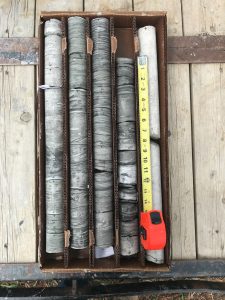What is Your Packer Test Actually Measuring?
Jun 10, 2020
 A critical part of the process for citing new or expanding existing solid waste facilities in Missouri is characterization of the underlying geological and hydrogeological conditions to evaluate their suitability for landfilling activities.Identifying and characterizing the uppermost confining unit beneath the solid waste disposal area is a major part of this characterization. Using bedrock coring and in-situ permeability testing, the uppermost confining unit can be identified and characterized to ensure regulatory requirements are met.
A critical part of the process for citing new or expanding existing solid waste facilities in Missouri is characterization of the underlying geological and hydrogeological conditions to evaluate their suitability for landfilling activities.Identifying and characterizing the uppermost confining unit beneath the solid waste disposal area is a major part of this characterization. Using bedrock coring and in-situ permeability testing, the uppermost confining unit can be identified and characterized to ensure regulatory requirements are met.
One of the more commonly used methods for determining in-situ permeability in low-permeability formations is the Packer Test. This in-situ test uses bladders, or packers, to seal off the borehole section of interest. Using water, a constant pressure is then applied to the sealed borehole interval and the resulting changes in water flow rate are measured (i.e. loss of water to the formation).
The ASTM D4630-96 Standard Test Method for Determining Transmissivity and Storage Coefficient of Low Permeability Rocks by In Situ Measurements Using the Constant Head Injection Test describes a packer assembly with a flow meter to measure water loss to the formation. This information is then used in the calculation of transmissivity, storativity, and ultimately hydraulic conductivity. It is essential when performing a packer test that the flow meter is calibrated, functioning properly, and meets the regulatory and ASTM standards for packer testing. In low permeability formations, these standards can lead to issues that may render your packer test unusable depending on the packer test setup and meter specifications.
In Missouri, many formations have naturally low hydraulic conductivities making them ideal confining units. Proper evaluation of these confining units to determine hydraulic conductivity becomes more challenging as hydraulic conductivities decrease. A major confounding variable in the accuracy of packer test results in low permeability settings is the ability of the flow meter to accurately measure low flow situations, or in some cases to even register that flow is occurring. The ASTM standard calls for a flow meter capable of measuring flow rates between 103 cm3/sec and 10-3 cm3/sec. However, flow meters that meet the ASTM standard may not meet individual state regulations or guidance. For example, Missouri regulations for solid waste facilities require a confining unit to have a hydraulic conductivity of 1 x 10-6 cm3/sec or less.
Much of the time, flow meters are provided by a subcontractor as part of the packer assembly equipment. While evidence of calibration is typically provided by subcontractors, it is equally important that the flow meter rates and specifications be reviewed prior to mobilization. Furthermore, the ASTM standard is not always compatible with individual state requirements. This can lead to test results that may not be useful depending on the governing regulatory requirements. To avoid this issue in low permeability situations, eliminating the flow meter altogether may be the best course of action. A packer assembly with no flow meter removes the variable of minimum flow rates, and essentially reduces the minimum to zero. This method utilizes a closed system with a reservoir of known size and shape from which volumes can easily be calculated mathematically. The reservoir is filled with water and pressurized with nitrogen. After the test is complete, the volume of water lost can be calculated by simple volume measurement.
This direct measurement method will yield a more accurate volume of water lost to the formation because there is limited possibility of flow that cannot be registered due to the inadequacies of an in-line flow meter. Excluding the leaking of water around the packers, there are only two places the water can go: to the formation or remaining in the reservoir. By measuring the initial depth to water in the reservoir and the depth to water after the test has been performed, a volume can then be calculated to determine the volume of water lost. In low hydraulic conductivity settings, this method may be preferred because very small quantities of loss can be detected and measured, allowing for more accurate results that meet more stringent regulatory standards. Blackstone was recently able to successfully use this test method at a site in Missouri for a series of 20 Packer Tests that required calculation of hydraulic conductivities of 1 x 10-6 cm3/sec or less. Prior to using this direct measurement method, Blackstone tested three flow meters that were either unable to meet the regulatory requirements or were unable to reliably measure small quantities of flow.